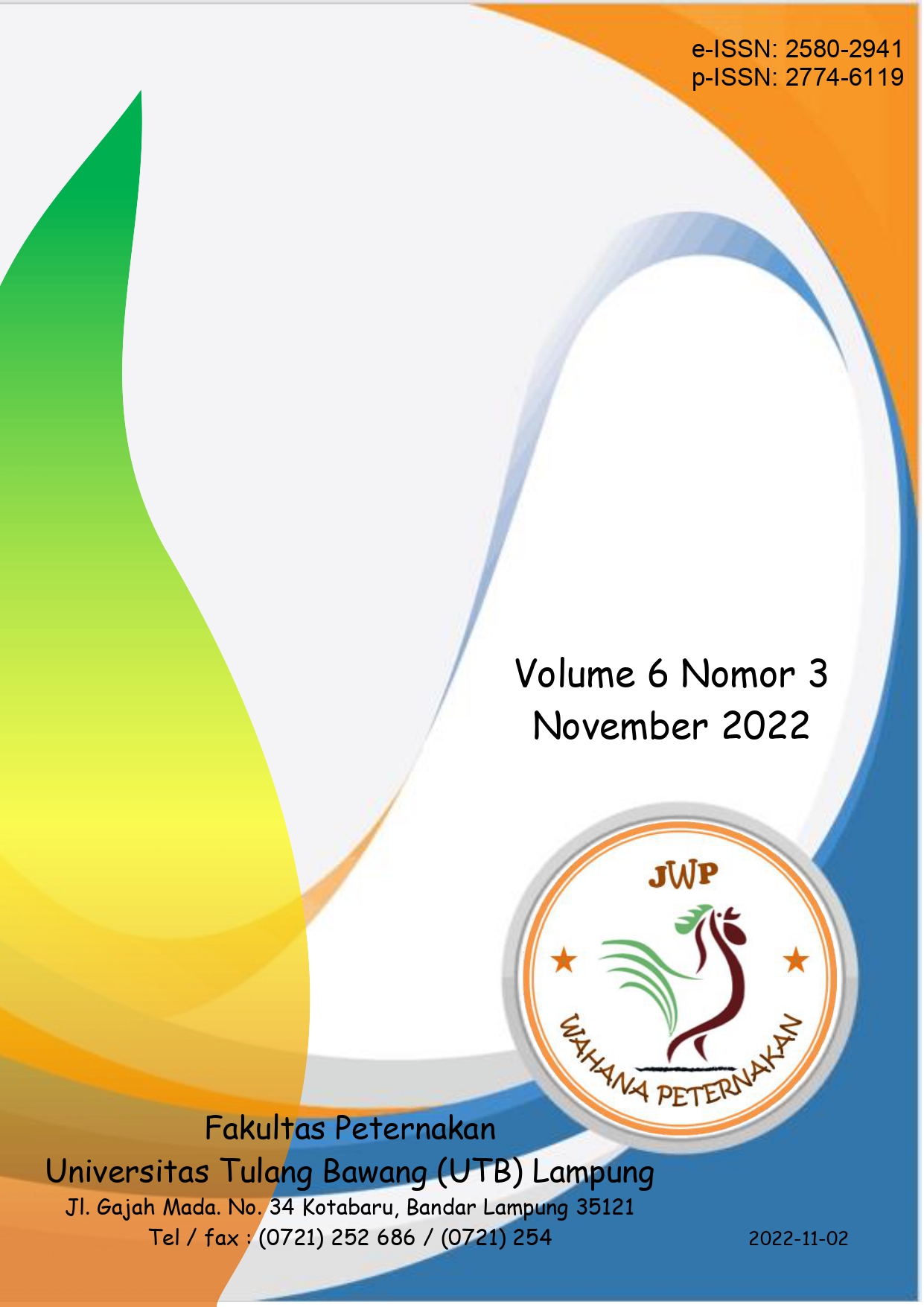PENGARUH PEMBERIAN POLIFENOL DARI TANAMAN HERBAL SEBAGAI NATURAL FEED ADDITIVE TERHADAP PERFORMA ANAK KAMBING DAN DOMBA
DOI:
https://doi.org/10.37090/jwputb.v6i3.628Abstract
The antibiotics as feed additive had been prohibited by the government regulation, because it was feared that it would pose a risk to livestock and residues in the products they produce. The ban is an opportunity for the development of innovations in feeding, such as the use of herbal plants as natural feed additives (NFA). The provision of NFA had been carried out by several researchers to the performance of kids and lambs. Kids and lambs are one of the key stages of successful sheep and goat farming. Kids and lambs that are healthy and have good performance will certainly be good breeds for livestock farming. Utilization of herbs and spices containing polyphenolic compounds has various effects on livestock, especially kids and lambs. The benefits or effects of NFA on kids and lambs are summarized in several studies, namely faster livestock growth, increased feed digestibility, feed efficiency, and economic efficiency. In addition, NFA also affects metabolic function and immunity, and reduces methane gas emissions without disturbing the rumen microbial population. Meat produced from kids and lambs supplemented with NFA also showed increased oxidative stability and increased PUFA and MUFA levels.
Keywords: additive, herb, polyphenol, goat, lamb, kids
Downloads
References
Akbarian, A., Golian, A., Kermanshahi, H., De Smet, S., & Michiels, J. (2015). Antioxidant enzyme activities, plasma hormone levels and serum metabolites of finishing broiler chickens reared under high ambient temperature and fed lemon and orange peel extracts and Curcuma xanthorrhiza essential oil. Journal of Animal Physiology and Animal Nutrition, 99(1), 150–162. https://doi.org/10.1111/jpn.12188
Balasundram, N., Sundram, K., & Samman, S. (2006). Phenolic compounds in plants and agri-industrial by-products: Antioxidant activity, occurrence, and potential uses. Food Chemistry, 99(1), 191–203. https://doi.org/10.1016/j.foodchem.2005.07.042
De Felice, E., Giaquinto, D., Damiano, S., Salzano, A., Fabroni, S., Ciarcia, R., Scocco, P., de Girolamo, P., & D’angelo, L. (2021). Distinct pattern of npy in gastro–entero–pancreatic system of goat kids fed with a new standardized red orange and lemon extract (Rle). Animals, 11(2), 1–14. https://doi.org/10.3390/ani11020449
Jabalbarezi Hukerdi, Y., Fathi Nasri, M. H., Rashidi, L., Ganjkhanlou, M., & Emami, A. (2019). Effects of dietary olive leaves on performance, carcass traits, meat stability and antioxidant status of fattening Mahabadi male kids. Meat Science, 153, 2–8. https://doi.org/10.1016/j.meatsci.2019.03.002
Kageyama, H., Takenoya, F., Hirako, S., Wada, N., Kintaka, Y., Inoue, S., Ota, E., Ogawa, T., & Shioda, S. (2012). Neuronal circuits involving neuropeptide Y in hypothalamic arcuate nucleus-mediated feeding regulation. Neuropeptides, 46(6), 285–289. https://doi.org/10.1016/j.npep.2012.09.007
Kalantar, M. (2018). The Importance of Flavonoids in Ruminant Nutrition. Archives of Animal Husbandry & Dairy Science, 1(1). https://doi.org/10.33552/aahds.2018.01.000504
Lambert, R. J. W., Skandamis, P. N., Coote, P. J., & Nychas, G. J. E. (2001). A study of the minimum inhibitory concentration and mode of action of oregano essential oil, thymol and carvacrol. In Journal of Applied Microbiology (Vol. 91, Issue 3, pp. 453–462). https://doi.org/10.1046/j.1365-2672.2001.01428.x
Manach, C., Scalbert, A., Morand, C., Rémésy, C., & Jiménez, L. (2004). Polyphenols: Food sources and bioavailability. American Journal of Clinical Nutrition, 79(5), 727–747. https://doi.org/10.1093/ajcn/79.5.727
Middleton, E., Kandaswami, C., & Theoharides, T. C. (2000). The Effects of Plant Flavonoids on Mammalian Cells:Implications for Inflammation, Heart Disease, and Cancer. Pharmacological Reviews, 52(4), 673 LP – 751. https://pharmrev.aspetjournals.org/content/52/4/673.abstract
North, M. K., Dalle Zotte, A., & Hoffman, L. C. (2019). The use of dietary flavonoids in meat production: A review. Animal Feed Science and Technology, 257(September). https://doi.org/10.1016/j.anifeedsci.2019.114291
Olagaray, K. E., & Bradford, B. J. (2019). Plant flavonoids to improve productivity of ruminants – A review. Animal Feed Science and Technology, 251(2019), 21–36. https://doi.org/10.1016/j.anifeedsci.2019.02.004
Petti, S., & Scully, C. (2009). Polyphenols, oral health and disease: A review. Journal of Dentistry, 37(6), 413–423. https://doi.org/10.1016/j.jdent.2009.02.003
Reddy, P. R. K., Elghandour, M. M. M. Y., Salem, A. Z. M., Yasaswini, D., Reddy, P. P. R., Reddy, A. N., & Hyder, I. (2020). Plant secondary metabolites as feed additives in calves for antimicrobial stewardship. In Animal Feed Science and Technology (Vol. 264, p. 114469). Elsevier B.V. https://doi.org/10.1016/j.anifeedsci.2020.114469
Rotondi, P., Colonna, M. A., Marsico, G., Giannico, F., Ragni, M., & Facciolongo, A. M. (2018). Dietary supplementation with oregano and linseed in garganica suckling kids: Effects on growth performances and meat quality. Pakistan Journal of Zoology, 50(4), 1421–1433. https://doi.org/10.17582/journal.pjz/2018.50.4.1421.1433
Sayed-Ahmed, M. E., & SHaarawy, A. M. (2019). Effect of feeding Moringa oleifera forage on productive performance of growing goat kids. Egyptian Journal of Sheep & Goat Sciences, 14(1), 25–37. https://doi.org/https://dx.doi.org/10.21608/ejsgs.2019.33232
Scalbert, A., Morand, C., Manach, C., & Rémésy, C. (2002). Absorption and metabolism of polyphenols in the gut and impact on health. Biomed Pharmacother, 56, 276–282. https://doi.org/10.1109/CCST.2012.6393568
Serra, V., Salvatori, G., & Pastorelli, G. (2021). Dietary polyphenol supplementation in food producing animals: Effects on the quality of derived products. Animals, 11(2), 1–44. https://doi.org/10.3390/ani11020401
Suman, M., Tyagi, A. K., & Phondba, B. T. (2015). Polyphenols rich plants extract supplementation to enhance the desaturation and antioxidant activity in goat kids. Indian Journal of Animal Sciences, 85(6), 593–600.
Tavarini, S., Castagna, A., Conte, G., Foschi, L., Sanmartin, C., Incrocci, L., Ranieri, A., Serra, A., & Angelini, L. G. (2019). Evaluation of chemical composition of two linseed varieties as sources of health-beneficial substances. Molecules, 24(20). https://doi.org/10.3390/molecules24203729
Wadhwa, M., & Bakshi, M. P. S. (2021). Potential of waste flowers used as feed additive on the performance of goat kids. Indian Journal of Animal Sciences, 91(10), 867–870.
Yuniarti, E., Evvyernie, D., & Astuti, D. A. (2016). Production and energy partition of lactating dairy goats fed rations containing date fruit waste. Media Peternakan, 39(1), 27–33. https://doi.org/10.5398/medpet.2016.39.1.27
Downloads
Published
Issue
Section
License
Copyright (c) 2022 Endah Yuniarti, Raden Febrianto Christi, Ken Ratu Gharizah Alhuur

This work is licensed under a Creative Commons Attribution-ShareAlike 4.0 International License.








